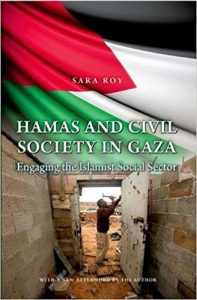Hamas and Civil Society in Gaza: Engaging the Islamist Social Sector

Reviewed by Irene Gendzier (Boston University), Middle East Policy Council, Winter 2012, (Princeton University Press, 2012, 336 pps.)
“Hamas and Civil Society in Gaza extends Roy’s decades-long inquiry by focusing on the Palestinian Islamist movement Hamas and its communal work, a dimension of its experience that is little known to nonspecialists. Yet it is one that is illuminating insofar as it reflects how Hamas translates its vision in terms that affect civil society through its work in education, health and the economy. The resulting narrative is enriched by the author’s lived experience in Gaza and by her commitment to giving voice to her subjects, their concerns and, above all, their humanity.”
“Roy’s study relies on meticulous research harvested over several decades, amplified in the present study by a broad array of interviews with diverse political figures in Gaza and the West Bank, including male and female social and political activists and professionals working in the West Bank, but primarily in Gaza, including in its refugee camps. In the process of explicating the context of these interviews, Roy repeatedly underlines what may seem to be truisms: history matters, the past is often very present, and a sensitivity to context is essential to the comprehension of events. In this instance, the Israeli occupation is key to such an understanding.”
“In situating Hamas, Roy reminds readers that Palestinian society was not notably sympathetic to the idea of an Islamic state, making the growing social constituency that was responsive to Hamas’s institutional innovations that much more significant. If Hamas was able to carve out such a supportive constituency, it was because it offered needed services with a professionalism that was appreciated. In short, it was not primarily the Islamic character of Hamas’s institutions that accounted for its appeal. Of course, the importance of that dimension cannot be eliminated in a context in which communal belonging and identity were under perpetual threat, as was the social and political fabric of Gazan society under occupation.”
“Hamas and Civil Society in Gaza illustrates the fact that “the Palestinian Islamist movement, especially in Gaza, is defined not only by political/military organizations such as Hamas but also by a range of social service institutions, many with a long history in the area” (p. 11). Such institutions, operating in Gaza and the West Bank, enhanced its participants’ sense of belonging and their capacity for meaningful social action and interaction, attributes whose importance can hardly be exaggerated in a society under occupation. Roy provides a number of examples of such institutions, some of whose operations she witnessed. Two of the many cases Roy cites include the kindergarten and rehabilitation programs of Gaza’s al-Ihsan Association for Disabled Children, in which mothers’ participation was a prerequisite that was beneficial to both parent and instructor. In Hebron, there was the al-Anwar al Ibrahimiyya Library for Children, containing some 17,500 volumes by 2008, a collection covering a broad range of subjects around which the library offered classes in reading as well as in computer science and English. Demand in both of the above cases was high, and these are but two examples.” (more…)
